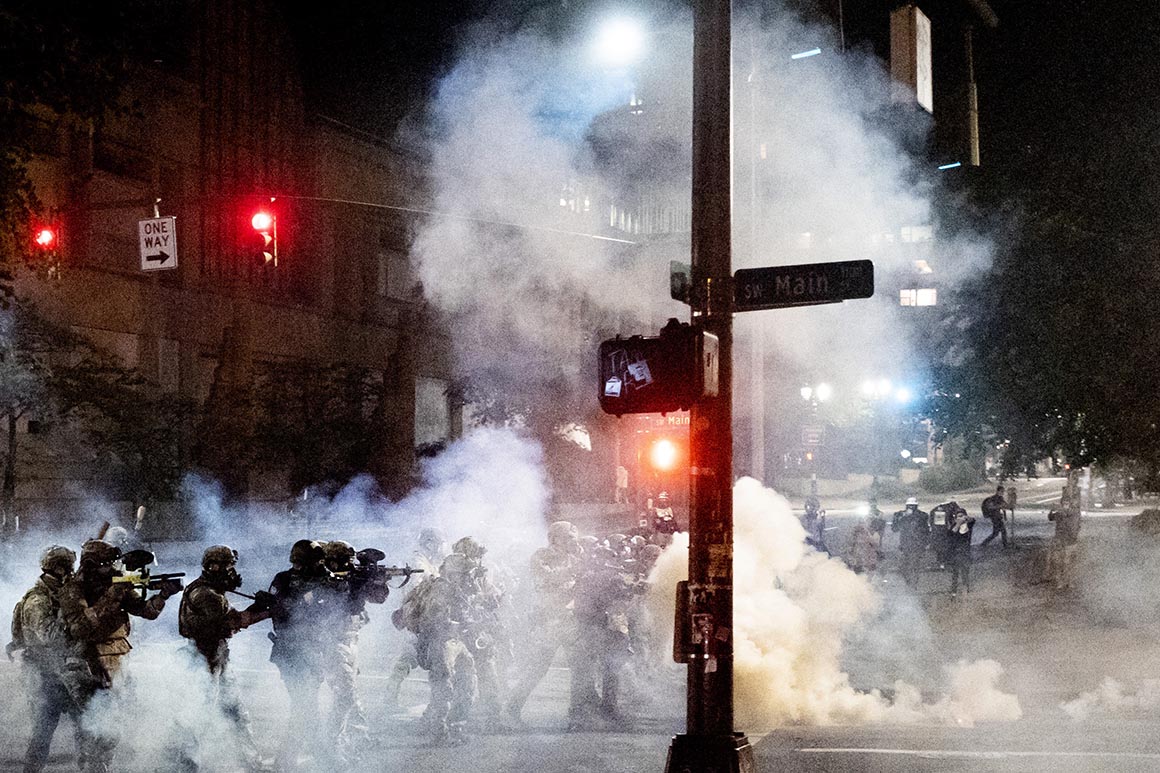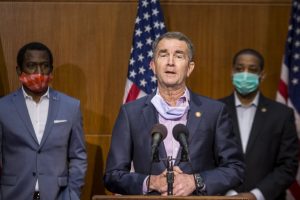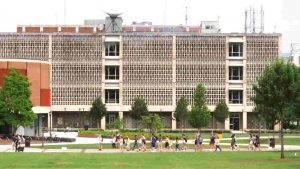In recent months, American cities have seen widespread protests
denouncing police brutality against unarmed Black people. Local and
national law enforcement agencies, responding to crowds of
unprecedented size and scale, relied on methods that were equally
unprecedented. In Portland, federal officers unleashed torrents of
tear gas and paintballs, pulled protesters into unmarked vans and
severely injured one demonstrator in front of a federal
courthouse.
Police in
Orlando,
Chicago, New York, and other cities resorted to the use of
long-range acoustic devices (LRADs), a weapon frequently used
by the U.S. military in sonic warfare and one with the potential to
cause permanent hearing loss to those exposed to it. Other tactics
were harsh enough to cause severe injuries, such as loss of vision,
in at least
12 reported cases. National Guard helicopters
hovered dangerously close to protesters in Washington,
capturing images and videos of the crowds, kicking up shards of
broken glass and sending many looking for
cover.
For many Americans, this seemed to be exactly how the federal
government is not supposed to respond to demonstrations in a
country that has a constitutionally protected freedom of assembly.
To be sure, in some cases, the harsher tactics were in response to
outbreaks of crowd violence, including attempted arson of local
police buildings in cities
such as Portland. But independent
expert reviews of police responses showed a clear pattern in
which use of excessive force by the police escalated many
confrontations. And to many watching at home or on the street, the
police response was widespread enough in cities that it appeared
the line between how law enforcement responds to mob violence and
how it responds to regular assembly had been blurred.
There’s a reason for that: For more than 30 years, the Supreme
Court has failed to take up a freedom-of-assembly case. As a
result, this fundamental constitutional right is in sore need of an
update, such as a ruling that would protect protesters from the
unduly harsh police response that has become all too common as a
response to demonstrations in recent years.
The First Amendment to the U.S. Constitution explicitly
describes the right of the people to peaceably assemble. This right
is recognized separately from the right to freedom of speech
because the founders believed that the act of organizing a
large crowd for a demonstration, parade or protest could be more
powerful than individual speech, and was therefore even more
susceptible to government encroachment. Like the right to religious
expression, the founders gave the right to protest its own listing
intending for the courts to give it special treatment and fashion
unique legal standards that would ensure its protection. This has
happened with the other specifically enshrined rights. With free
speech, for example, the Supreme Court has in recent years defined
specific kinds of modern speech—computer code, or speech
on the internet—and protections for them.
But over the past 50 years, the courts have ducked that
responsibility to protect the freedom of assembly, laying the
groundwork for the hyperaggressive police response to protests that
is observed in the streets today.
The Supreme Court shirked this responsibility first by holding
that the right to assembly did not protect anything like the right
to protest in the streets, beginning with a formative ruling in
1886. At the time, labor unrest and revolt were widespread, and
many state governments were passing laws aimed at preventing
potential insurrections by workers’ organizations. It had also
become common practice for state police and troops to violently
disperse labor union meetings and demonstrations, and in response
to this practice, many labor groups began arming their members.
When one group of German-American socialist workers organized a
parade in Chicago, in which members carried unloaded rifles,
members of the group were prosecuted for marching in the streets
without a license from the governor. In addition to claiming that
their Second Amendment right to bear arms had been violated, the
members claimed that by marching in the streets, they were
exercising their right to assembly.
The Supreme Court ruled that the right to assembly did not give
a blanket right to protest in the streets. Instead, the court ruled
that the First Amendment protected the right to speak to the
government only through activities such as forming a
political group or lobbying
Congress. In effect, the justices subsumed the right to protest
within the more expansive right of freedom of speech, suggesting
that the right to protest would be subject to the same protections
as individual speech.
But that’s not what happened. In fact, the court has over the
years declined to protect the right to protest with one of the most
important legal standards they have used to protect freedom of
speech: the chilling-effect doctrine. This doctrine, first used by
the Supreme Court and then frequently cited afterward in
free-speech decisions in lower courts, holds that fear of
government punishment can deter free expression as strongly as
application of actual punishment. In cases involving individual
speech, the courts rely on the chilling-effect doctrine to prohibit
government action that makes people afraid to speak on a certain
topic.
The origins of the chilling-effect doctrine go back to the Cold
War. The U.S. government knew that it could not prohibit
individuals from producing communist literature or joining
communist organizations without violating the First Amendment right
to free speech. Instead, to achieve the same goal, states and
federal government passed laws that would have revealed to the
government the identity of those sympathetic to the communist
cause. For example, state employees were asked to
take an oath of allegiance to the government of the United States,
and those wanting to receive communist literature were asked to
give their information to the U.S. Postal Service before receiving
such material through mail.
Although none of these actions would have directly punished
individuals for expressing their beliefs, the Supreme Court was
quick to see the new threat they posed to the freedom of speech. It
was enough, the Court ruled, that these requirements created an
atmosphere of fear around certain expressions and that many might
self-censor in the future out of fear of punishment. The Supreme
Court found both of the above-mentioned laws to be unconstitutional
in two separate rulings, citing the chilling-effect doctrine.
The court had already made the suggestion earlier that the
freedom of assembly was essentially an extension of the freedom of
speech, which would also seem to mean that the chilling-effect
should apply to the freedom of assembly, too. But that is not how
courts have ruled. For decades, lower-level courts ignored requests
to apply the chilling-effect doctrine to harsh crowd-control
tactics, finding the advocates’ plea that such practices can
impact future participation in protests to be tenuous.
The courts’ failure to update Americans’ understanding of
the freedom of assembly has given law enforcement free rein to
deploy strategies that increasingly have the potential to deter
future participation in protests. This is nowhere more evident than
in the type of the cases that make their way to the courts. Whereas
10 years ago the courts had to decide
whether NYPD’s use of mounted police that frequently stepped on
protesters’ feet was objectionable (they decided that it was
not), today they hear cases about armies of special forces equipped
with riot gear, chemical weapons and other top-level military-grade
weaponry. Every step of this transformation in policing crowds has
been fueled by the courts’ refusal to rein in the proclivity for
an increasingly stronger show of force.
But a slew of new cases gives the courts a new chance to revisit
many of the faulty assumptions that have long bedeviled their
approach to the right to protest.
This month, Oregon Attorney General Ellen Rosenblum, sued the
federal government over the exercise of harsh protest-suppression
methods in Portland. Rosenblum asked the federal court to declare
such “police-state tactics,” to be unconstitutional, citing its
potential to have a chilling effect on future lawful participation
in protests. Similar lawsuits have been initiated by local activist
groups in
Chicago and in
Minneapolis. In other cities,
such as Seattle, legislative authorities are filling the gaps
left by the courts, banning the use of nonlethal weapons, such as
acoustic weapons and chemical irritants. In Oregon, Rosenblum’s
request was blocked due to standing—meaning that someone else
will have to raise the issue—and the pace of the other decisions
will likely be slow because of the pandemic.
But the courts could finally have a chance to revisit the role
they have played in shaping the slow eradication of the right to
protest in the United States, the right that gave us the march to
Selma and the women’s vote. And we should hope that this time,
they find it worth protecting.



















